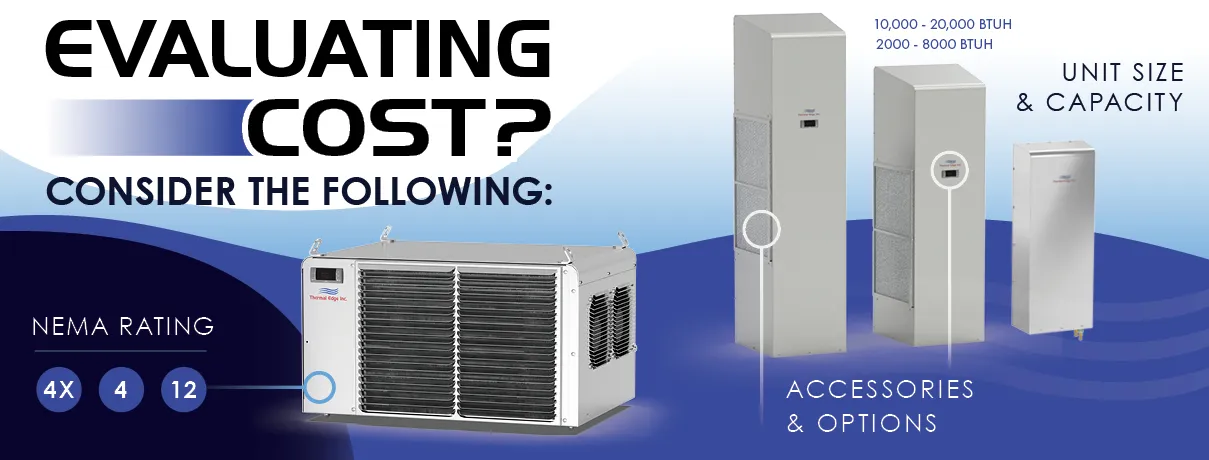How to Evaluate Cost for Enclosure Air Conditioners

If the temperature goes up, the maintenance cost of your electrical equipment is bound to go up without efficient temperature control inside the enclosure. You may want to assess your heat loads, cooling requirements and the costs associated with buying and installing an air conditioner before your equipment starts experiencing failure due to high temperature. There are many factors that could drive the cost of your enclosure air conditioner.
Size of your equipment
The most important factor that will determine the cost of your enclosure air conditioner is its cooling capacity, which is a direct measure of its size. Manufacturers provide enclosure air conditioners with cooling capacities from 1000 BTU to 20,000 BTU. For electrical equipment located indoors that dissipate less heat, you may be able to get away with smaller air conditioners. As the heat load of the equipment goes up, the size of the enclosure air conditioner increases as well. The physical difference in the construction of a small air conditioner and a large one is driven by the size of their compressors and condenser and evaporator coils. An increase in the size of individual components increases the overall cost of the air conditioner.
Features – Options and Accessories
Manufacturers make enclosure air conditioners for a wide variety of applications. While the standard unit can take care of your cooling requirements, your application itself may require additional features to handle the extreme conditions the environment poses. For instance, in a petrochemical plant or a water treatment facility, you will want to invest in corrosion protection for the condenser and evaporator coils and refrigeration tubing.
You may want to be able to program the unit and monitor the enclosure temperature from your desktop. There are options that provide redundant systems with alternating operation for situations where failure of your sensitive equipment may not be acceptable. For excessively dusty environments, you can invest in an extended-capacity filter that increases the time between maintenance routines for your air conditioner. As useful as options are for your air conditioner, they come at a price. To maximize the value of an air conditioner, it should have only the features you need for your application
NEMA rating
Enclosure air conditioners are designed for use with different NEMA type enclosures. NEMA 12 enclosures are designed for indoor use with minimal protection against falling dirt and water ingress. NEMA 4 and 4X standards are used to specify enclosures designed for indoor or outdoor applications, and offer a higher degree of protection against foreign objects and moisture. The design of the air conditioners has to be compliant with the NEMA type enclosures they are intended for use with. The cost of the air conditioner is dependent upon its NEMA type rating, NEMA type 12 air conditioners costing less than NEMA type 4 and 4X variants.
Standard features vs. options
It is important to understand the standard features in enclosure air conditioners when you evaluate their cost. Standard features in air conditioners differ from manufacturer to manufacturer. For instance, most manufacturers do not provide an efficient condensate evaporator for their standard air conditioner, but provide a drain hose to eliminate the water. Others offer standard condensate evaporation systems, either power consuming or power reducing. Some manufacturers provide digital controllers as standard while others do not. An air conditioner that offers advanced features as standard components may cost a little more than one that offers them as paid upgrades, but the benefits need to be evaluated when making the purchase decision.
Installation and maintenance costs
The final component of the purchase price of an air conditioner is the inevitable cost associated with installation and routine maintenance of the equipment. For a first-time installation, you might have to utilize the services of a contractor to prep your enclosure to house your air conditioner; this includes drilling and cutting holes in the enclosure, using installation gaskets to seal the holes and installing fasteners to mount the unit. Enclosure air conditioners are designed to be low-maintenance equipment; the only maintenance costs you should incur are for cleaning and filter replacement.
Aside from these major contributors to the cost of your air conditioner, there can be differences in operating cost. It is wise to compare the power consumption by noting the running amps for each model.
If you want to get a free quote for the enclosure air conditioner that best suits your requirements, contact the sales team at Thermal Edge today.

